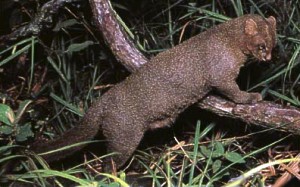|
Weight:
16 pounds
Head/Body: 26 inches
Tail: 18 inches
Subspecies: 8
The Jaguarundi is believed to be the descendants of the Puma (ancestral), which originates from Asia. A Jaguarundi may not look like a cat in the traditional sense, and some people may say that it resembles an otter or weasel, more than a cat. They can be found in Central America, South America all the way south to Argentina, and very rarely in Texas and New Mexico.
The Jaguarundi's color goes from dark brown to a chestnut hue. Jaguarundis have short legs, small heads and weasel-like ears. The litter size is usually between 1-4 kittens and they are born after a gestation period of approximately 70 days. Upon being born, a Jaguarundi is spotted, but loses these marks when they reach 4 months. They reach maturity at about 22-24 months of age.
They are genetically closer to the bigger felids, as their chromosome number is 38, just like the jaguar, while other small felids have only 36 chromosomes. A Jaguarundi is usually seen in lowland territories with a dense cover, like forests and scrub areas. They are more often than not found near running water, so it is no wonder that they are excellent hunters of fish.
They catch them with their front paws, but they eat other prey too. They hunt mainly during the day, but evidence exists that they also hunt during the twilight periods. They climb well, but hunt mainly on the ground.
Although they are not hunted much for their fur, their numbers are on the way down. This is principally caused by deforestation and habitat loss, which is the major reason why so many animals become endangered.
In the United States, where sightings of the cat are very rare, it is classified as an endangered species. Four sub-species of Jaguarundi are listed in CITES Appendix I with the remaining sub-species in Appendix II. The IUCN Red Book classifies the Jaguarundi as �Least Concern�.

|



